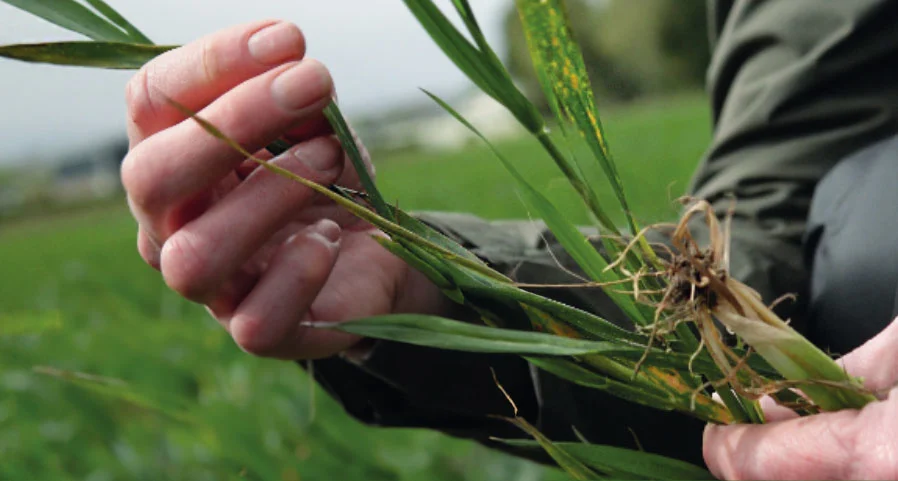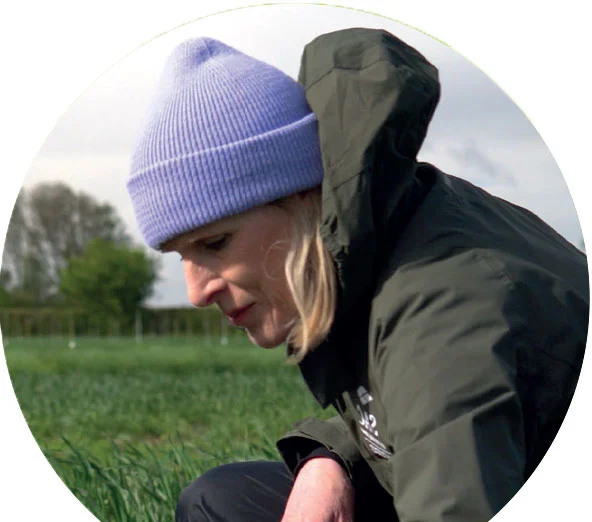
With the T1 fungicide timing fast upon us, last week Bayer’s Crop Doctors embarked on their first tour of the season, visiting sites in North Yorkshire, Lincolnshire and Herefordshire to assess crop development and disease levels.
The very wet and relatively mild winter has inevitably provided conditions favourable to septoria at all sites. But with high levels of yellow rust in commercial crops, together with reports of eyespot and brown rust in some regions, the Crop Doctors were keen to get into the plots of current AHDB Recommended List and candidate varieties to form a nationwide picture of the disease challenges facing growers this season.
With a wide variation in crop development, there was also plenty of discussion around the importance of correctly identifying leaf 3 emergence to ensure that T1s are applied for optimal effect.
Author
| 19th April 2024Tags
We Highly Recommend:
Fungicides
Vimoy
A fungicide for the control of foliar diseases in wheat. Vimoy® contains Iblon® (isoflucypram) the groundbreaking new active substance that delivers unrivalled broad-spectrum disease control.
Read moreCrop Doctor - Still plenty of potential to protect at T1
North – Cawood, North Yorkshire
Small plants and active yellow rust
It is a bitterly cold day in North Yorkshire and Fiona Burnett, professor of applied plant pathology at SRUC, is carefully stripping leaf layers away from the stem of a young wheat plant with fingers that are growing increasingly numb.
She will do this several more times in the next hour or so to determine the growth stage of this plant and others in a field of 35 winter wheat varieties at Bayer’s trials site at Cawood near Selby.

Prof Fiona Burnett, Arable Knowledge Lead, SRUC
Although there are discernible differences in development between the varieties in terms of their height and biomass, most have four leaves emerged on the main stem on this October 18-drilled, sandy clay loam site, although those on a slightly wetter area of the field are a little more backward, feeling the effects, no doubt, of having wet feet for most of the winter.
“I would say that generally, plants here seem smaller than we might normally expect at this time of year,” says Fiona. “They are still sitting quite low to the ground.”
A brief spell of dry weather allowed the team at Cawood to apply a T0 of 0.5 litres per hectare of Folicur (tebuconazole) on April 10 and disease levels are generally quite low, although septoria is present at low levels in almost all varieties.
Dipping into plots at random, Fiona notes that Graham is looking clean, KWS Dawsum has a little bit of septoria on its lowest leaves while a few rows down, Champion is sporting a few spots of yellow rust.
“I’ve seen worse septoria here at this point in the season in previous years, but it has been present in crops over the winter and levels are starting to climb, which is inevitable given it has been persistently wet,” says Fiona.
In search of some properly active yellow rust, she dives off into a plot of Zyatt, rated 3 for resistance to the disease, and isn’t disappointed.
“Yellow rust is plastered over leaf 6,” she says.
While brown rust has been reported in crops further south and west, it isn’t currently finding conditions at Cawood to its liking.
Eyespot is also absent at the site but is an important consideration at the T1 fungicide timing given that none of the top 10 winter wheat varieties for yield on the AHDB Recommended List have an eyespot rating above 6, says Bayer’s Tom Sowerby.
“Stem bases here actually look quite clean and that is a positive, but an October 18 drilling is not particularly early,” he says, referencing the increased eyespot risk with earlier drilling.
With T1 sprays approaching, correct identification of crop growth stage will be particularly important this year, given the wide variation seen in winter wheat development across regions, farms and even within fields as a result of the wet weather, says Fiona.
At Cawood Zyatt is the most forward, with leaf 3 just peeping out and is a good two weeks ahead of some of the later varieties on the site.
“The rule of thumb is that the T1 spray is applied at GS32, which is when leaf 3 is emerging,” says Fiona.
“But GS32 is something of a made up growth stage, where there are two distinct internodes visible, and you can measure two centimetres between them.
“However, some varieties are taller than others, in some years crops are shorter and basically, the crop doesn’t know that we’ve set this two centimetre rule.
“This year crops are short here and so the classic GS32 rule may not apply. Peeling back leaf layers and counting what leaves have emerged will be important and wait until leaf 3 is properly emerged before going in with the T1.”
Acknowledgements
Ascra contains prothioconazole, bixafen and fluopyram. Vimoy contains isoflucypram. Ascra, Iblon, and Vimoy are registered Trademarks of Bayer. All other brands listed may be Trademarks of other manufacturers and proprietary rights may exist. Use plant protection products safely. Always read the label and product information before use. Pay attention to the risk indications and follow the safety precautions on the label. For further information visit www.cropscience.bayer.co.uk or call Bayer on 0808 1969522.
We Highly Recommend:
Fungicides
Vimoy
A fungicide for the control of foliar diseases in wheat. Vimoy® contains Iblon® (isoflucypram) the groundbreaking new active substance that delivers unrivalled broad-spectrum disease control.
Read moreEast - Long Sutton, Lincolnshire
Plenty of septoria and yellow rust
A little over 100 miles south and the weather is in capricious mood at Bayer’s Long Sutton site near Spalding in Lincolnshire. There is still a bitingly cold north-westerly blowing but sunshine is breaking through heavy grey clouds to shine a spotlight on the tractors and planters busy at work on host farm G H Hoyles Wisbech Series grade 1 silts.
NIAB pathologist Aoife O’Driscoll is eager to see what the plots have to offer and with Skyfall and Zyatt closest to hand she is quick to find both septoria and yellow rust.
“There is more septoria in the Skyfall, but the yellow rust levels are about the same in the two varieties,” she says.

Dr Aoife O’Driscoll, Plant Pathologist, NIAB
With 35 winter wheat varieties in the ground at this site there is plenty to look at. KWS Vibe is looking good, with no visible signs of disease and is a little less forward than the Zyatt and Skyfall.
Loxton has plenty of active yellow rust lurking in the base of the canopy, but disease has not yet spread to the uppermost leaves, and there is very little septoria to be seen.
Extase is showing a little bit of septoria but “nothing that would need treating now”, says Aoife and yellow rust levels are low compared to those seen in Zyatt and Skyfall.
“Is it worth treating the Extase for the yellow rust at this point, probably at this site, yes,” says Aoife, with a nod to the Long Sutton’s site’s location in the high risk rust region around the Wash.
KWS Ultimatum is backward but very clean, while KWS Palladium is clearly finding the site to its liking, looking strong, with no sign of yellow rust.
LG Redwald looks more advanced here than at sites elsewhere, notes Aoife. “And there is quite a lot of septoria in the base - more than I would expect,” she says.
So high is the rust pressure at Long Sutton that there is a ‘Rust Alley’ trial comparing the effects of different T1 and T2 fungicide treatments on yellow and brown rust.
In these plots Crusoe is showing a small amount of yellow rust in the canopy base but there is very little brown rust to be seen, says Bayer’s Emily Harrod.
“At this site it is perhaps still a little early for brown rust. It will probably rear its head at some point here later in the season but at the moment things are pretty clean.”
Looking out across the site, Aoife remarks on the variation evident in the plots.
“We can see differences in terms of tillering and crop height in particular. And what we are seeing on-farm generally is a lot of variation in leaf layer emergence across and even within fields,” she says.
“We might have to go back in a couple of weeks after the T1 because there is such huge variation in terms of leaf layer emergence. There will probably be a lot of T1.5s going this year because it will be quite difficult to get a well-timed T1 on.”
With this scenario in mind, Aoife’s advice is to include two SDHIs in the fungicide progamme, at T1 and T2, and make sure that the T1 is well-timed.
Emily adds that Iblon (isoflucypram), available in a co-pack as Vimoy® with prothioconazole , is a good all-rounder, fitting well at the T1 timing, when there may be multiple diseases to target.
“Here at Long Sutton, we do need something that is going to give a lot of protection at T1. Vimoy® would be a really good option to keep yellow rust and Septoria levels under control,” she says.
Acknowledgements
Ascra contains prothioconazole, bixafen and fluopyram. Vimoy contains isoflucypram. Ascra, Iblon, and Vimoy are registered Trademarks of Bayer. All other brands listed may be Trademarks of other manufacturers and proprietary rights may exist. Use plant protection products safely. Always read the label and product information before use. Pay attention to the risk indications and follow the safety precautions on the label. For further information visit www.cropscience.bayer.co.uk or call Bayer on 0808 1969522.
West – Callow, Herefordshire
Stage set for a septoria season
There has been barely a day without rain at Callow in Herefordshire in the last two months, says Bayer’s Greg Hanna.
“So far this year we’ve has 361mm of rain here. It's been the worst spring I can recall for continuously wet conditions,” he says.
With two drilling dates at the site - October 5 and October 16 – there is a big difference in development across varieties and drilling dates, says Greg, but the later drillings are a little more backward and thinner than would typically be expected, particularly as the site is north-facing.
Not surprisingly septoria is on the move in the 50 varieties in the trial plots. As yet there is no yellow rust, but brown rust is already present in Crusoe, while Beowulf has a good smattering of mildew, says ADAS’ Chloe Morgan.
“It has been so wet and mild - perfect conditions for septoria to get going in crops quite early on,” she says.
“I think there will be a lot of varieties this year that carry more disease than we would expect, and we will probably have more latent infection than we would normally have.”
Chloe’s colleague, ADAS crop protection technical director Jonathan Blake, is concerned that this season is potentially set up to be the worst septoria season for a long time.
“It's certainly starting off like a season that could be really bad. We are going to need good chemistry and robust rates,” he says.

Jonathan Blake, Technical Director of Crop Protection, ADAS
Stem-base browning associated with eyespot is also visible in the plots and while the degree to which it penetrates stems depends on the weather in the coming weeks, an eyespot-active T1 will provide good insurance.
“Given the rain we've had there is still a significant eyespot threat, even if the initial inoculum isn't quite as high or potentially as high compared to last year,” says Jonathan.
“We were very lucky last year that we had the dry spell that allowed the outer infected sheaths to roll back and separate from the stem and prevent eyespot penetrating. We were very close to having penetrating lesions in many crops but were saved by the dry weather.”
Where yellow rust is present and T0s were planned and missed because of the weather, a late T0 and a short interval between T0 and T1 may be a better bet than trying to chase rust at T1, adds Greg.
“You could have a lot of rust there by the time you get to T1,” he says.
Deliberately delaying T1 is not an option, he stresses.
“That approach will mean leaf 3 will be exposed for too long.”
Trimming back fungicide spend on what are seen as already compromised crops could be tempting this spring but, given the current septoria and yellow rust pressure, and plenty of eyespot and brown rust being reported from round the regions, it is important to try and protect yields, adds Greg.
“You've got to treat crops for the disease risk, rather than the perceived potential of the crop. If you make the wrong decisions at T1 it is easy to be faced with something at T2 that you can't do anything about.
“Think about risk and where the risk comes from - variety and drilling date - and target your fungicides accordingly.
“For example, if you have some earlier drilled Dawsum, my go-to would be Vimoy®; if you’ve got Extase and it is later-sown I’d be really happy with Ascra® at T1.
“What I wouldn't be doing would be using the better products but dropping the rates down too low because I don’t think you get the benefits from them then.”
When it comes to fungicides the easiest decisions to make are those around early sown, disease-susceptible varieties, says Jonathan.
“We want to be using the best available chemistry, at high rates with a multi-site.
“I think we could be facing septoria Armageddon. It really could be the worst septoria season we’ve seen for a very long time.
“I genuinely think that had we had a more normal end to the season last season we would have had 3-4t/ha yield responses to fungicides and that could easily be where we are this year,” he says.
Acknowledgements
Ascra contains prothioconazole, bixafen and fluopyram. Vimoy contains isoflucypram. Ascra, Iblon, and Vimoy are registered Trademarks of Bayer. All other brands listed may be Trademarks of other manufacturers and proprietary rights may exist. Use plant protection products safely. Always read the label and product information before use. Pay attention to the risk indications and follow the safety precautions on the label. For further information visit www.cropscience.bayer.co.uk or call Bayer on 0808 1969522.